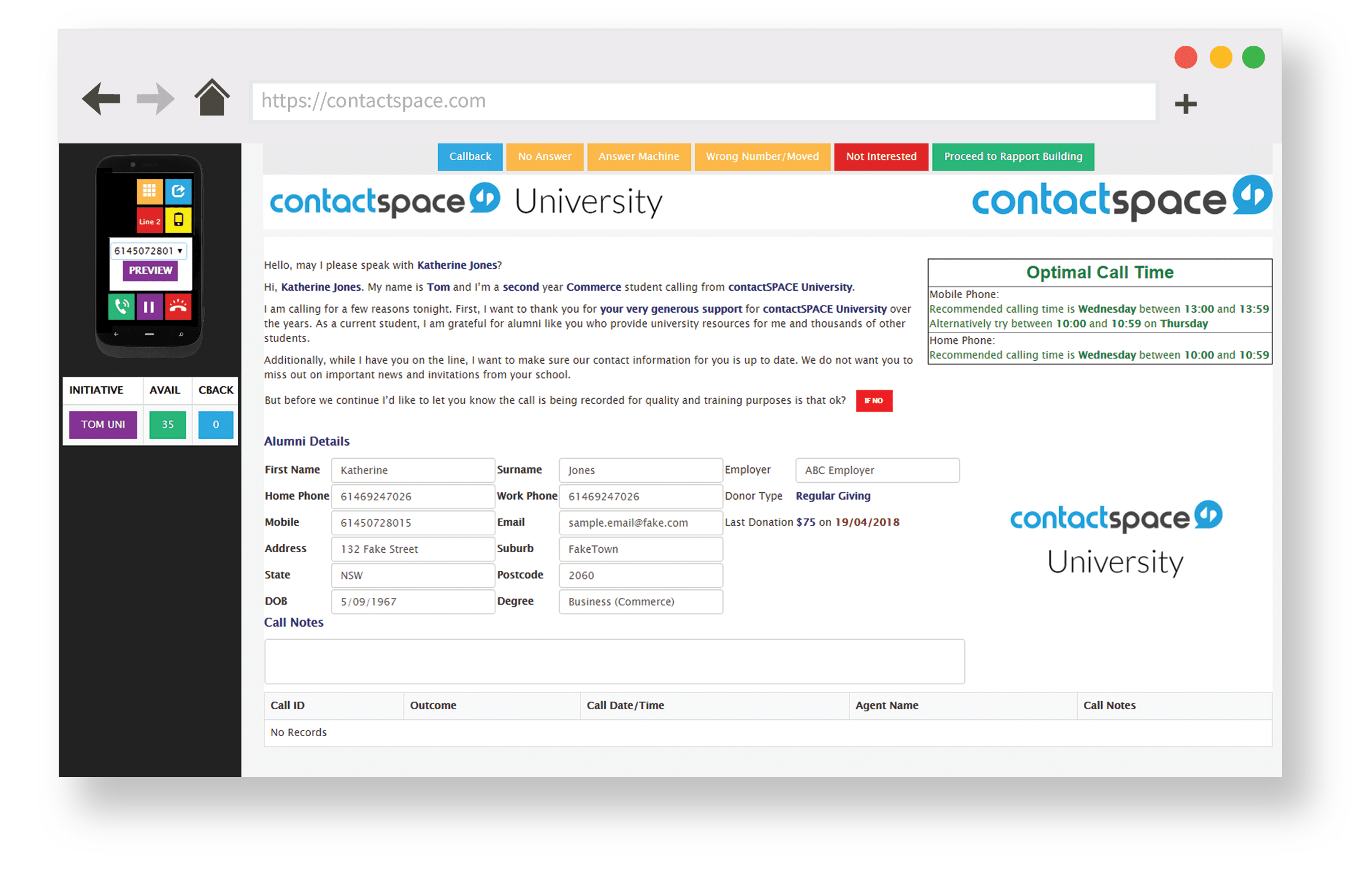If you lead an alumni engagement team for a college or university, one of your main responsibilities is probably raising money to help support the institution.
Conducting effective fundraising for a university can be challenging, for a number of reasons. People wanting to make philanthropic donations often look to charities before considering donating to the university they graduated from.
To stay front-of-mind of your alumni, and achieve great results when fundraising, there are a number of best practices you can use as an alumni engagement professional.
1. Keep in touch

The one advantage you have as a university over most other philanthropic organisations is your network of alumni.
Successful colleges and universities already have a group of graduates they can call on for support. This means that you can develop a much more effective pitch when compared to most charities, which we’ll discuss in more detail below.
Therefore, it’s important to keep in touch with your alumni network in order to promote better engagement.
Best practice is for universities to use a team of student callers, to allow for one-to-one conversations with each alumnus.
In general, multi-channel campaigns, especially integrating voice calling, tend to perform better when compared to mass-email campaigns.
Above all, it’s important to prioritise the quality of the contact your callers are making. We’ll explain how you can achieve this in more detail below.
2. Personalise your messaging

As you keep in touch with your alumni, it’s important to personalise your messaging.
This is an area where you can leverage the data you likely have on-hand as a university. Typically, educational institutions will know a lot more about their graduates than charities know about their donors.
Think about:
- Pairing the alumni to the student caller based on the degree and major of each. You could also match people based on their extra-curricular interests, for example, sports clubs or fraternities.
- Developing different messaging based on the degree, major, or interests of the alumni. For example, a person who studied medicine may be more interested in contributing to medical research than to a sports scholarship.
- Developing different ask strategies based on the alumni’s stage in life. For example, you may want to ask for something different from someone who graduated two years ago compared to someone who has been in the workforce for a decade.
Here at contactSPACE, our software allows you to set up all of this personalisation and call-routing logic, without having to write a single line of code.

We help some of the world’s best universities, charities, and fundraising agencies achieve incredible results on their phonathon campaigns, by allowing them to deliver better-quality, more personalised contact. Learn more about how our solution works.
3. Use intelligent contact

When making outbound contact, it’s important to have a strategy about how you will be getting in touch.
This is especially true when making phone calls, where brute-force dialling methods are becoming less and less effective.
Aggressive contact strategies can lead to over-dialling, causing your numbers to get blocked by the people you’re calling. As a result, these numbers get flagged as spam by mobile phone providers, further reducing contact rates.
In fact, due to over-dialling and robo-calling, on average nearly half of all phone calls in the USA are left unanswered.
However, there are now more intelligent ways to get in contact, and ensure that your alumnus picks up the phone.
Consider the following:
- What time of day would the alumnus prefer to be called?
- If they don’t pick up the first time, how can we ensure they answer on the second attempt?
- When they still don’t pick up, how many attempts should we make before giving up?
- How can we follow-up post conversation, or when someone fails to pickup?
These may seem like impossible questions to answer. However, here at contactSPACE, we have developed some solutions to these problems:
- Call-time optimisation – call at the time of day that the specific phone number is most likely to pick up.
- CLID rotation – attempting contacts from different phone numbers based on which types of numbers are answered most often.
- Recall rules – shelving a record after a certain number of attempts based on the reason it wasn’t answered (voicemail, number dead, etc) to minimise time wastage.
- Templated email/SMS-based followups, for example to provide donation confirmation information, or to request a callback.
4. Prove the need

This applies to any type of fundraising – it’s a fundamental part of asking for donations.
Think about why the university needs funds, and why they’re needed now.
Creating a sense of urgency is an important step, otherwise it’s easy for the graduate to put off the donation for the time-being, only to never contribute to your cause.
To prove the need, the first step is to state what the funds will specifically be used for. Doing so can be especially effective if you can tie this initiative into a specific interest of the alumnus, as we described earlier.
The second step is to show that the funding goals haven’t quite been reached. You’re aiming to show that without alumni contributions, the initiative is unlikely to go ahead.
To execute these two steps correctly, it’s crucial that you’re able to keep your team on-message. Learn more about how we keep student callers on-message with dynamic CallGuides®.
5. Prove the impact

Now that the graduate understands why their university needs their support, you need to be able to show that their money will be used effectively.
Think about any relevant projects or programs that have been funded through donations in the past, and link them to the initiative that the university is now raising money for. Then, link to the positive impact that these initiatives have had.
For example, the university may have previously funded a scholarship for gifted soccer players, and is now trying to fund a similar program for basketball players. You would then talk about some of the students who have come through the soccer scholarship program and what they’ve achieved when trying to raise funds for the basketball scholarship.
6. Provide more options

Some people would like to make a one-time donation. Others may be more interested in a monthly contribution, so that they don’t have to donate a large lump sum.
At times, a bequest may be a more appropriate option.
For some people, donating simply isn’t an option at the time you ask for their support. However, this doesn’t mean that they aren’t able to help out.
Would someone be willing to volunteer at an on-campus open day? Would they be interested in providing feedback about their degree? Or would they like to mentor a current student?
Remember, the more engaged someone is with the university after they’ve graduated, the more likely they are to donate funds in the future.
7. Demonstrate interest

There is nothing worse for a recent university graduate than to be cold called with a pitch along the lines of “Hi [name] I’m calling from [university]. We saw that you graduated three years ago, would you like to donate to our scholarship fund?”.
Apart from developing a more personalised appeal based on the person’s interests as we described above, it’s also important to show genuine interest in what the graduate is doing now that they have left the university.
This is important because they may be considering further study, and wish to explore their options. Although your student callers might not be able to provide detailed information about post-graduate degrees, these fundraising teams should be prepared to hand over these calls to the appropriate department.
8. Build relationships

Another benefit of showing interest in your alumni’s post-university life is it enables you to build closer relationships with your graduates.
The most immediate reason that this is useful is that graduates may not be able to afford to donate at the time you get in contact. However, if you’re able to build a relationship, they’ll be much more likely to want to contribute if their financial situation changes.
Having closer relationships also allows the university to build a stronger alumni network. Many of the universities we work with here at contactSPACE have been able to build a stronger graduate community through successful alumni engagement, with the university at its core.
With larger individual donors, you may want to assign a specific person inside the university to manage the relationship on an ongoing basis. This one-to-one relationship is all about finding out the graduate’s needs – why they want to donate, the causes they care about, and how they are able to contribute to the university.
However, it’s important to reserve these one-to-one relationships only for your most important donors. Otherwise, your team will be stretched thin, reducing the quality of the stewardship you can provide.
9. Provide self-service options

While phone campaigns are almost always the most effective way to raise money as a university, it’s important to provide self-service facilities for those that need them.
For example, some alumni may be busy professionals who would love to donate, but never have the time for a long phone conversation.
To cater for this audience, you could create a landing page on your website for your fundraising campaign. On this page, you would provide:
- Some details about the appeal(s) you are running – what the funds are being raised for.
- Some FAQs – for example, whether donations are tax deductible, how to set up a monthly gift, etc.
- A basic payment gateway to make the donation online.
10. Refine your ask

There are an almost infinite number of ways to ask for a donation when having a conversation with an alumnus.
Therefore, it’s important to be constantly refining not just your pitch, but also your ask.
There are a few ways to go about doing this:
- Use voice analytics to better-understand conversation sentiment and test different pitch/ask strategies.
- Do a more simple A/B test of different strategies. Meaning, try strategy A on 100 calls, and strategy B on 100 calls, and see which results in a better conversion rate. Just ensure that the sample size is large enough to ensure statistical significance.
It’s important to be certain that your contact strategies are consistent between callers. It will be impossible to test different strategies if every caller is delivering the message a different way.
This is why contactSPACE CallGuides® are designed specifically to keep students on-message, while still allowing them to personalise their pitch.
11. View fundraising as an investment

In order to execute an effective fundraising strategy, there needs to be enough resources allocated to the campaign.
Having a student caller team for example, and managing the team effectively, isn’t cheap and easy to do.
It’s important to view fundraising campaigns as a long-term investment that will generate more than just a financial return.
As Eric Thomas, former vice-chancellor of the University of Bristol describes it:
“Actively choosing to resource fundraising is not just about financial return on investment. For me there are three additional areas of benefit:
- Fundraising concentrates the institution on a clear articulation of its strategy;
- It brings influential and important stakeholders much closer to your university;
- Success brings liberation, and is excellent for morale.”
If your fundraising strategy does not have the necessary buy-in, it’s going to be very difficult to get the resources you need to achieve great results.
To secure buy-in for greater investment in fundraising, be sure to highlight the non-financial results that the campaign can deliver, as well as the financial benefits. For example, greater alumni awareness of their options for further study, as well as greater funds available for scholarship programs.
